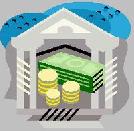
 |
|
| Financial Terms | |
| current yield |
|
Information about financial, finance, business, accounting, payroll, inventory, investment, money, inventory control, stock trading, financial advisor, tax advisor, credit.
Main Page: money, business, investment, credit, payroll, inventory, stock trading, finance, |
Definition of current yield
current yieldAnnual coupon payments divided by bond price. Current yieldFor bonds or notes, the coupon rate divided by the market price of the bond. Current YieldThe percentage return on a financial asset based on the current price of the asset, without reference to any expected change in the price of the asset. This contrasts with yield-to-maturity, for which the calculation includes expected price changes. See also yield.
Related Terms:YieldThe interest rate that makes the present value of a stream of future payments associated with an asset equal to the current price of that asset. Also called yield to maturity. See also current yield. Annual percentage yield (APY)The effective, or true, annual rate of return. The APY is the rate actually Bond equivalent yieldBond yield calculated on an annual percentage rate method. Differs from annual Bond-equivalent yieldThe annualized yield to maturity computed by doubling the semiannual yield. Capital gains yieldThe price change portion of a stock's return.  Convenience yieldThe extra advantage that firms derive from holding the commodity rather than the future. Coupon equivalent yieldTrue interest cost expressed on the basis of a 365-day year. Current accountNet flow of goods, services, and unilateral transactions (gifts) between countries. Current assetsValue of cash, accounts receivable, inventories, marketable securities and other assets that Current couponA bond selling at or close to par, that is, a bond with a coupon close to the yields currently Current liabilitiesAmount owed for salaries, interest, accounts payable and other debts due within 1 year. Current issueIn Treasury securities, the most recently auctioned issue. Trading is more active in current Current maturitycurrent time to maturity on an outstanding debt instrument. Current rate methodUnder this currency translation method, all foreign currency balance-sheet and income  Current ratioIndicator of short-term debt paying ability. Determined by dividing current assets by current Current-coupon issuesRelated: Benchmark issues Dividend yield (Funds)Indicated yield represents return on a share of a mutual fund held over the past 12 Dividend yield (Stocks)Indicated yield represents annual dividends divided by current stock price. Earnings yieldThe ratio of earnings per share after allowing for tax and interest payments on fixed interest Effective annual yieldAnnualized interest rate on a security computed using compound interest techniques. Equivalent bond yieldAnnual yield on a short-term, non-interest bearing security calculated so as to be Equivalent taxable yieldThe yield that must be offered on a taxable bond issue to give the same after-tax Flattening of the yield curveA change in the yield curve where the spread between the yield on a long-term High-yield bondSee:junk bond. Indicated yieldThe yield, based on the most recent quarterly rate times four. To determine the yield, divide Liquid yield option note (LYON)Zero-coupon, callable, putable, convertible bond invented by Merrill Liquid yield option note (LYON)Zero-coupon, callable, putable, convertible bond invented by Merrill Lynch & Co. Non-parallel shift in the yield curveA shift in the yield curve in which yields do not change by the same Other current assetsValue of non-cash assets, including prepaid expenses and accounts receivable, due Parallel shift in the yield curveA shift in the yield curve in which the change in the yield on all maturities is Pure yield pickup swapMoving to higher yield bonds. Realized compound yieldyield assuming that coupon payments are invested at the going market interest Relative yield spreadThe ratio of the yield spread to the yield level. Reoffering yieldIn a purchase and sale, the yield to maturity at which the underwriter offers to sell the bonds Required yieldGenerally referring to bonds, the yield required by the marketplace to match available returns Riding the yield curveBuying long-term bonds in anticipation of capital gains as yields fall with the Steepening of the yield curveA change in the yield curve where the spread between the yield on a long-term Weighted average portfolio yieldThe weighted average of the yield of all the bonds in a portfolio. YieldThe percentage rate of return paid on a stock in the form of dividends, or the effective rate of interest Yield curveThe graphical depiction of the relationship between the yield on bonds of the same credit quality Yield curve option-pricing modelsModels that can incorporate different volatility assumptions along the Yield curve strategiesPositioning a portfolio to capitalize on expected changes in the shape of the Treasury yield curve. Yield ratioThe quotient of two bond yields. Yield spread strategiesStrategies that involve positioning a portfolio to capitalize on expected changes in Yield to callThe percentage rate of a bond or note, if you were to buy and hold the security until the call date. Yield to maturityThe percentage rate of return paid on a bond, note or other fixed income security if you Yield to worstThe bond yield computed by using the lower of either the yield to maturity or the yield to call Current assetsCash, things that will be converted into cash within a year (such as accounts receivable), and inventory. Current liabilitiesBills a company must pay within the next twelve months. Current ratioA ratio that shows how many times a company could pay its current debts if it used its current assets to pay them. The formula: Current assetsAmounts receivable by the business within a period of 12 months, including bank, debtors, inventory and prepayments. Current liabilitiesAmounts due and payable by the business within a period of 12 months, e.g. bank overdraft, creditors and accruals. current assetscurrent refers to cash and those assets that will be turned current liabilitiescurrent means that these liabilities require payment in current ratioCalculated to assess the short-term solvency, or debt-paying dividend yield ratioCash dividends paid by a business over the most Bond Equivalent YieldBond yield calculated on an annual percentage rate method Current RatioA measure of the ability of a company to use its current assets to Effective Annual YieldAnnualized rate of return on a security computed using compound Yield CurveA graphical representation of the level of interest rates for Yield to MaturityThe measure of the average rate of return that will be earned on a concurrent engineeringsee simultaneous engineering labor yield variance(standard mix X actual hours X standard rate) - (standard mix X standard hours X standard rate); material yield variance(standard mix X actual quantity X standard price) - (standard mix X standard quantity X standard price); process quality yieldthe proportion of good units that resulted from the activities expended yieldthe quantity of output that results from a specified input yield ratiothe expected or actual relationship between input and output Par yield curveThe yield curve of bonds selling at par, or face, value. Spot curve, spot yield curveSee Zero curve. Yield a. Measure of return on an investment, stated as a percentage of price. Yield curveGraph of yields (vertical axis) of a particular type of security Yield to maturityA measure of the average rate of return that will be earned Zero curve, zero-coupon yield curveA yield curve for zero-coupon bonds; Current assetTypically the cash, accounts receivable, and inventory accounts on the Current costUnder target costing concepts, this is the cost that would be applied to a Current liabilityThis is typically the accounts payable, short-term notes payable, and Production yield varianceThe difference between the actual and budgeted proportions yield curveGraph of the relationship between time to maturity and yield to maturity. yield to maturityInterest rate for which the present value of the bond’s payments equals the price. Current AccountThat part of the balance of payments accounts that records demands for and supplies of a currency arising from activities that affect current income, namely imports, exports, investment income payments such as interest and dividends, and transfers such as gifts, pensions, and foreign aid. Current DollarsA variable like GDP is measured in current dollars if each year's value is measured in prices prevailing during that year. In contrast, when measured in real or constant dollars, each year's value is measured in a base year's prices. Yield curveA graph showing how the yield on bonds varies with time to maturity. Current Tax Payment Act of 1943A federal Act requiring employers to withhold income taxes from employee pay. Current Income Tax ExpenseThat portion of the total income tax provision that is based on Current AssetsCash and other company assets that can be readily turned into cash within one year. Current LiabilitiesDebts or other obligations coming due within a year. Current Ratiocurrent assets divided by current liabilities. This ratio indicates the extent to which the claims of short-term creditors are covered by assets expected to be converted to cash in the near future. Back-up1) When bond yields and prices fall, the market is said to back-up. Related to : financial, finance, business, accounting, payroll, inventory, investment, money, inventory control, stock trading, financial advisor, tax advisor, credit. |